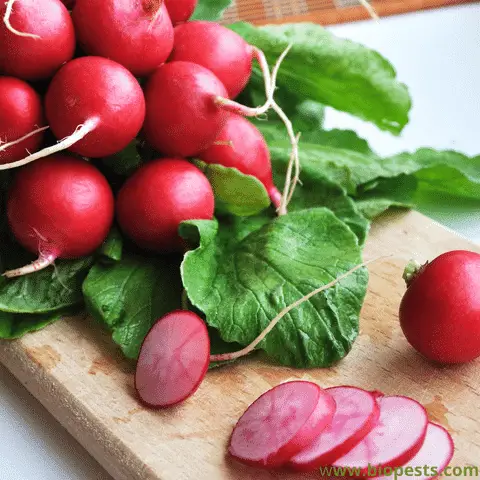People enjoy radishes because of their many nutritional benefits and taste. Most raw radishes have a crisp, semi-sweet, peppery flavor that is perfect on their own or in salads. This flavor goes slightly milder and sweeter when you cook them, giving you a less intense kick. But, sometimes, you get a bitter taste that is neither normal nor pleasant, but why?
Bitter radishes were planted at the wrong time of year or did not receive appropriate fertilization or water. The bitterness does not necessarily mean that the radish is off but does point to lower quality. There are exceptions. For example, the Black radish variety is naturally bitter.
Different radishes have different organic flavors. Some varieties, like the Red Globe, Easter Egg, Icicles, or Daikon, have a hot, peppery taste that should not be confused with being bitter. Bitterness is acrid, like the taste of citrus peel, unsweetened cocoa, or black coffee. If you do encounter a bitter radish, do not discard them immediately. There are ways to enjoy them in your food still.
What Causes The Bitterness Of Radishes?
The basic requirements for good radish growth are a mild climate, sufficient sunlight, soil with enough nutrients and fertilizers, and regular watering. Without this, the radishes can experience strain and yield a bitter result.
Radishes flourish during the cooler seasons, preferring temperatures of about 50-65 °F (10-18 °C). Hotter temperatures and large temperature fluctuations will cause the plant environmental stress and will thus produce more pungent radishes with spicier roots and a bitter taste. It would be best if you, therefore, planted them during the spring and fall.

Soil also plays an integral part in the quality of radishes. If one plants radishes in the ground that does not contain enough nutrients for them to grow, or they are not receiving enough moisture, it results in crops with a bitter taste. You must regularly add fertilizer and organic matter to the soil of radishes to allow them to grow optimally, thus avoiding a bitter harvest.
Even if the soil you plant radishes in contains enough nutrients, you must always check the pH balance. Ground that is too acidic (low pH) or too basic (high pH) causes radishes to be unable to absorb nutrients; this, in turn, results in inferior radishes that taste bitter. A moisture meter (like this one available on Amazon) can really help you to control the moisture and Ph level in the soil and determine if the plant is getting adequate light.
When Are Radishes Ready To Eat?
If you planted your radishes, you must check their size and texture to know when to harvest them.
Radishes grow pretty rapidly. Some varieties can be ready to eat as soon as three weeks after planting them. Check their size first by removing the top layer of soil around one of the radish plants to get a better view of them. They might be ready for the picking if the radish is about 1in/2.5cm in diameter.
To be sure, pull one radish out of the soil to test its firmness before harvesting them all. Gently squeeze the radish. If it is firm, then the radishes should be ready to eat. Once radishes have reached maturity, it is best to harvest them as soon as possible. Leaving them in the ground after they reach their peak will cause the radishes to deteriorate quickly.
How To Remove The Bitterness From Radishes
One way to remove bitterness is to peel and soak your radishes in salt water for 2-3 minutes or boil the radishes in boiling salt water for 3-5 minutes, after which you must clean them in cold water. Many also swear by using starch water left after you have cooked rice. The starch helps to absorb the bitterness. You can also put a handful of rice in clean water and boil the radishes.
Another way to eliminate the bitter taste of radishes is to pickle them. Slice and salt your radishes to draw out any bitter juices. Then marinade the salted radishes in a mixture of rice vinegar and sugar for at least one hour.
If you want to reduce the bitter taste of radishes in cooked dishes, you can counteract the sharpness by adding sweetness or salt to your food. Saltiness can come from table salt, anchovies, soja sauce, and other high salt ingredients. You can get sweetness from adding sugar, honey, or fruit to your dish.

Is It Safe To Eat Bitter Radishes?
Depending on the radish variety, the leafy green tops are one part that can be bitter even when fresh and of superior quality. You can safely consume this wonderfully nutritious part of the radish, but many people discard it because of its distinct bitterness. This flavor, along with a peppery taste, is natural to the leaves and poses no harm when consumed.
You can eat radish leaves raw or cooked, although, in their natural state, they have a fuzzy, unpleasant texture. Cooking the leaves softens them, making them more palatable. These leaves are versatile and can be sautéed, braised, or steamed and used in soups, stews, curries, stir-fries, frittatas, or quiches.
The root of a radish plant is the normal part that people primarily consume. If you harvest or buy radishes that taste bitter, it does not mean they are off. Simply reducing the bitterness by soaking or boiling them in salt water will relieve you from its sharp, astringent flavor and be quite enjoyable in your favorite dish.
Still, it is best if you exercise some caution. If you experience a bitter radish showing additional deterioration, you should discard the radishes instead.
How To Know If Radishes Are Bad
Radishes are available year-round but checking if they are of good quality when you purchase or harvest them is vital. Even the freshest radishes can sometimes taste bitter, but this is not a cause for concern. To establish if it is safe to eat calls for a more comprehensive assessment than merely relying on its flavor alone.
The first thing you will probably notice about radishes is their visual appearance. If you see any signs of decay, like mold, rot, or discoloration (white or brown scars or black spots), you should refrain from consuming the radishes since they are signs of deterioration. If the leafy greens are still attached to the radishes, they should look new and green, not limp or yellow.
You might also notice the smell of radishes soon after picking or buying them. It can, potentially, point to the radish being off if the scent is powerful. However, first, determine whether the odor is just the natural aroma of the radish and then take further steps to confirm your suspicions.
Touching the radishes will help you to determine their texture. A fresh radish should be firm and crunchy, which will be especially obvious when you cut through them. If a radish feels mushy (soft) when you gently press them, you should instead discard them to be safe.
Cooking With Bitter Radishes
If your radishes are bitter, it is best to peel them before cooking. Peeled radishes are milder in flavor than with their skin intact. The next step is to separate the roots and the leaves. Cut the greens off and store or discard them, depending on your needs.
To prepare the radishes, soak them in salt water (if they are bitter), wash them under cold running water and drain them. After this step, you can grate, slice, or cut your radishes to the desired size or leave them whole. If it is the first time you cook radishes, treat them like any root vegetable. Associating it with something more familiar will give you more confidence to cook them.

There are many ways to cook radishes, all of which will help to tame their bitterness. The most common way to cook radishes is to boil, steam or roast them.
To boil radishes, bring salt water to a simmer on the stovetop. Once boiling, drop the whole, sliced, or cut radishes in the water. Let the radishes cook until tender, like the way you would boil potatoes. You can then add a herby dressing or butter to the boiled radishes. This process will take about 10-30 minutes, depending on the type of radish and the size in which you prepared them.
Steaming radishes work best in a steamer, but you can also use a wok. After they are ready, you can add them to a salad or make steamed radish cakes. This method only takes 5-15 minutes, depending on the type of radish, preparation method, and the desired tenderness.
You can roast radishes on the stovetop or, even better, in the oven. Preheat your oven to 425° F (218°C). Mix your cut or whole radishes with olive oil and season it to your liking by adding salt, pepper, garlic, and herbs. Spread the radishes onto a baking sheet or roasting pan and let them roast in the oven for 30-45 minutes, regularly checking to see if they are tender and browning.
Conclusion
Fresh radishes can taste bitter, but this should not discourage you from eating them. Bitter radishes are perfectly safe to eat if they are firm, crisp, and have no discoloration. They have abundant nutritional benefits, and it would be sad to discard perfect radishes because of their bitterness.
To reduce the sharpness of any bitterness or even to mellow the naturally spicy taste of radishes, you can prepare them in salt water and then cook them like any other root vegetable. They are excellent boiled, steamed, or roasted. With a little extra help from salt or a bit of sweetness, you won’t even know that the radishes were ever bitter.
If you are a radishes lover, check out these articles!
Why Radishes Get Worms? Tips On How To Solve This Problem
Which Radishes Are The Spiciest? What Makes Them Spicy
Radish Vs. Horseradish. What’s The Difference?
Why Do Radishes Taste Like Soil? Here Is Why
Some of the links above are affiliate links, meaning, at no additional cost to you, I will earn a commission if you click through and make a purchase.

